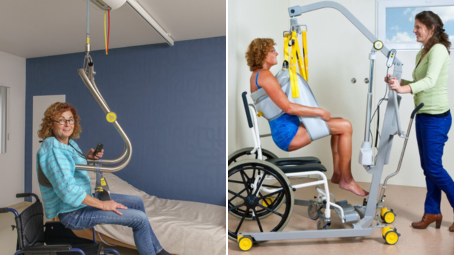
Enhancing Mobility and Independence: A Guide to Medical Lift Installation
For individuals with limited mobility or those recovering from injuries, maintaining independence within their homes can be a significant challenge. Medical lifts offer a solution, providing safe and convenient assistance with transferring between floors or getting in and out of bathtubs. However, proper installation is crucial to ensure the lift functions effectively and maximizes user safety.
Understanding Medical Lifts:
Medical lifts come in two primary categories:
- Ceiling Lifts: These permanent fixtures consist of a track system mounted on the ceiling and a motorized hoist that glides along it. A sling attached to the hoist supports the user during transfers. Ceiling lifts offer greater flexibility and can cover multiple rooms or floors within a home.
- Portable Lifts: These freestanding units typically have a base that widens for stability and a motorized lifting mechanism. Portable lifts are ideal for occasional use or in situations where installing a ceiling lift isn’t feasible.
Benefits of Medical Lift Installation:
- Improved Independence: Medical lifts empower individuals with limited mobility to navigate their homes more independently, performing daily tasks like bathing or accessing different floors.
- Reduced Risk of Falls: Transfers can be a risky endeavor for those with mobility issues. Medical lifts minimize fall risks during transitions from beds, chairs, bathtubs, or toilets.
- Increased Caregiver Safety: Caregivers often face potential back strain or injuries when manually assisting with transfers. Medical lifts alleviate this burden, promoting safe and effortless transfers.
- Enhanced Quality of Life: Increased mobility and reduced dependence on others contribute to a better overall quality of life for individuals with limited mobility.
The Medical Lift Installation Process:
A smooth and successful medical lift installation involves several key steps:
- In-Home Assessment: A qualified professional will visit your home to assess your specific needs and living space. They will consider factors like doorways, ceiling height, bathroom layout, and weight capacity requirements to determine the most suitable lift type and placement.
- Lift Selection and Customization: Based on the assessment, the professional will recommend a specific lift model that best suits your needs. Options for slings, harnesses, and track layouts can be customized to ensure optimal functionality and user comfort.
- Installation: Trained technicians will perform the installation, ensuring proper anchoring of the ceiling track system for ceiling lifts or setting up the portable lift for secure operation.
- Safety Training: A crucial step is thorough training for the user and their caregivers on safe operation, transfer techniques, emergency procedures, and proper maintenance of the lift.
Choosing a Medical Lift Installation Company:
- Licensing and Insurance: Ensure the company is licensed and insured to perform medical equipment installations in your area.
- Experience and Certifications: Opt for companies with experience in installing medical lifts, particularly those with technicians certified by lift manufacturers.
- Warranty and Support: Inquire about warranty coverage for the lift and the availability of ongoing maintenance and support services.
- Customer Reviews and References: Reading online reviews and requesting references from past clients can provide valuable insights into the company’s reputation and service quality.
Conclusion:
Medical lift installation can significantly improve the lives of individuals with limited mobility, allowing them to maintain greater independence and safety within their homes. By understanding the advantages of medical lifts, the installation process, and how to choose a reputable installation company, you can ensure a smooth transition toward a more comfortable and independent living environment.






